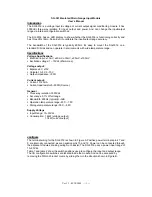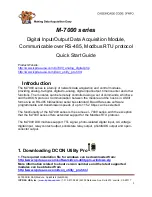
11 of 40
Copyright © D 363 -06/99
Section C3 —DHW with Low Temperature Boilers (without Mixing)
If DHW is to be incorporated into a low temperature system such as a radiant heating system, a mixing device is often installed to isolate
the high DHW supply temperature from the lower system supply temperature. If a mixing device is not installed, high temperature water
could be supplied to the low temperature system while trying to satisfy the DHW demand. This may result in damage to the low
temperature heating system. The 363 is capable of providing DHW in such a system while ensuring that the low temperature in the
heating system does not exceed its allowed maximum setting.
To prevent high temperature water from being introduced into the heating system, the Boiler Pump (P1) must be turned off during a
call for DHW. To do this,
DHW THRU
must be set to
PUMP
,
DHW PRI
must be set to
B + M,
and
Boil MIN
must be set to
OFF
.
On a call for DHW, the 363 provides DHW priority by shutting off the Boiler
Pump (P1) for a period of time. This time is based on the outdoor air
temperature as described in the DHW Priority Override section. If the
DHW
Demand is not satisfied within the allotted time, the boiler shuts off and the
boiler’s heat is purged into the DHW tank.
Once the boiler supply temperature is sufficiently reduced, the DHW pump
shuts off. Then the heating system is turned on for a period of time to
prevent the building from cooling off. After a period of heating, if the DHW
demand is still present, the 363 shuts off the heating system and provides
heat to the DHW tank once again.
For correct operation, close attention must be paid to the mechanical layout of the system. When the 363 turns off the Boiler Pump (P1),
flow to the heating system must stop. If flow is not stopped, the temperature in the heating system can exceed the maximum desired
temperature and can result in damage to the heating system.
Section C4 —Setpoint
The 363 can handle setpoint loads which are high temperature loads connected to the boiler loop that are not heating loads or DHW.
For this feature to be available, either a DHW sensor must be used or the
DHW THRU
item is set to
NONE
. If an external DHW demand
is used as described in Section C1, you cannot use the setpoint feature.
SETPOINT DEMAND
The 363 registers a
Setpoint Demand when a voltage between 24 and 240 V (ac) is applied
across the
Setp / DHW and the Com Dem terminals (5 and 3). Once voltage is applied, the
setpoint demand pointer turns on in the LCD. The control operates the boiler to maintain at
least the boiler supply temperature as set by the
SETPOINT
Occ setting. The Setpoint Demand
does not turn on the Boiler Pump (P1). If a setpoint load is used, the installer must make sure
that the setpoint device provides its own flow through the boiler.
BOILER TARGET DURING SETPOINT (
Boil TRG
)
The
Boil TRG
temperature during a
Setpoint Demand is increased to at least the
SETPOINT
setting. This temperature is maintained as long as the 363 has a
Setpoint Demand.
SETPOINT SETBACK (
SETPOINT
UnOcc)
If the 363 is placed into setback, the
Setpoint Dem is ignored if the
SETPOINT
UnOcc setting is set to
OFF
. Otherwise, the setpoint
operates normally. If a system override of
AWAY
is selected, the 363 operates the
SETPOINT
load at the
Occupied setting.
SETPOINT PRIORITY (
SETP PRI = B+M
)
For setpoint loads to have priority over the Boiler and Mixing zones, set
SETP PRI
to
B + M.
If this option is chosen, the output from
the mixing device is suspended and the Boiler Pump (P1) turns off during a
Setpoint Demand.
Priority Override
In order to prevent the building from cooling off too much or the possibility of a potential freeze up during setpoint priority, the 363 limits
the amount of time for setpoint priority. As the outdoor air temperature becomes colder, the length of time the 363 provides setpoint
priority is reduced. Once the allowed time for priority has elapsed, the 363 overrides the setpoint priority and operates setpoint and
heating simultaneously.
Conditional Setpoint Priority
If the
Boil SUP
temperature is maintained at or above the required temperature during setpoint generation, this indicates that the boiler
has enough capacity for setpoint and possibly heating as well. As long as the
Boil TRG
temperature is maintained, setpoint and heating
occur at the same time.
Sequence, Section C3 Sequence, Section C
3
4
Com
Dem
Boil
Dem
Setp/
DHW
5
24 to 240 V (ac)
P
P1
DHW












































